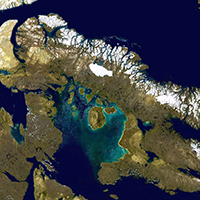Physical and chemical characteristics of 1300 lakes and ponds across the Canadian Arctic
Characteristics of Canadian Arctic lakes and ponds

All claims expressed in this article are solely those of the authors and do not necessarily represent those of their affiliated organizations, or those of the publisher, the editors and the reviewers. Any product that may be evaluated in this article or claim that may be made by its manufacturer is not guaranteed or endorsed by the publisher.
Authors
Lakes and ponds are a major feature of the Arctic landscape and are recognized as effective ‘sentinels of change’. Here we present water chemistry characteristics of lakes and ponds (n=1300 with 26 variables) across the Canadian Arctic collated from published studies. We also extracted geological and ecoregion data in an attempt to determine the key drivers. In general, most lakes were shallow (85.4%, <10 m), nutrient (phosphorus) poor (oligotrophic = 45.6% and ultra-oligotrophic = 24.8%), located at low elevation (66.5%, <200 m asl), close to coastlines (72.5%, 0-50 km), and underlain by sedimentary geology (66.5%). The first two components from Principal Component Analysis explained 49.3% of the variation in the dataset; the first component was dominated by conductivity/carbonate materials, and the second component suggested allochthonous inputs of phosphorus. In general, bedrock geology is the primary driver of water chemistry; as such, there were major differences between lakes underlain by igneous and sedimentary rocks. Those on sedimentary bedrock tend to have higher pH, nutrients and higher inorganic ion concentrations.






